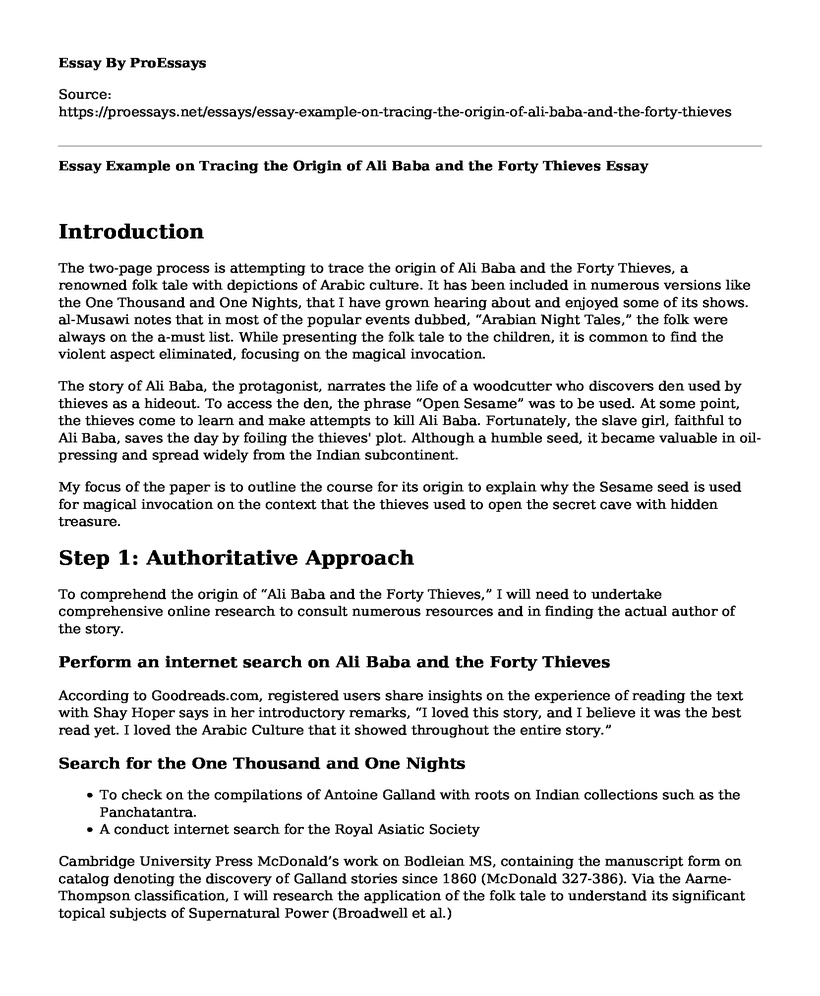Introduction
The two-page process is attempting to trace the origin of Ali Baba and the Forty Thieves, a renowned folk tale with depictions of Arabic culture. It has been included in numerous versions like the One Thousand and One Nights, that I have grown hearing about and enjoyed some of its shows. al-Musawi notes that in most of the popular events dubbed, “Arabian Night Tales,” the folk were always on the a-must list. While presenting the folk tale to the children, it is common to find the violent aspect eliminated, focusing on the magical invocation.
The story of Ali Baba, the protagonist, narrates the life of a woodcutter who discovers den used by thieves as a hideout. To access the den, the phrase “Open Sesame” was to be used. At some point, the thieves come to learn and make attempts to kill Ali Baba. Fortunately, the slave girl, faithful to Ali Baba, saves the day by foiling the thieves' plot. Although a humble seed, it became valuable in oil-pressing and spread widely from the Indian subcontinent.
My focus of the paper is to outline the course for its origin to explain why the Sesame seed is used for magical invocation on the context that the thieves used to open the secret cave with hidden treasure.
Step 1: Authoritative Approach
To comprehend the origin of “Ali Baba and the Forty Thieves,” I will need to undertake comprehensive online research to consult numerous resources and in finding the actual author of the story.
Perform an internet search on Ali Baba and the Forty Thieves
According to Goodreads.com, registered users share insights on the experience of reading the text with Shay Hoper says in her introductory remarks, “I loved this story, and I believe it was the best read yet. I loved the Arabic Culture that it showed throughout the entire story.”
Search for the One Thousand and One Nights
- To check on the compilations of Antoine Galland with roots on Indian collections such as the Panchatantra.
- A conduct internet search for the Royal Asiatic Society
Cambridge University Press McDonald’s work on Bodleian MS, containing the manuscript form on catalog denoting the discovery of Galland stories since 1860 (McDonald 327-386). Via the Aarne-Thompson classification, I will research the application of the folk tale to understand its significant topical subjects of Supernatural Power (Broadwell et al.)
Step 2: Theoretical Approach
I will examine the application of an intriguing theory that relates the cry of ‘Open Sesame!’ to the nature of the plant. Usually, once the pods mature, rupturing occurs as if force is exerted internally, and the seeds scatter on the farm. Just as Ali Baba safeguarded the secret, farmers tend to be cautious when plucking mature pods, drying occurs, and later opening to remove the seeds. It is a procedural process.
Perform internet research on fandom.com to capture the plot details and inclusion to the “One Thousand and One Nights”. Refer to fairytale.fandom.com to contextualize on the plot to follow how Ali Baba became instrumental. Yet, he was just a poor woodcutter and the safeguarding of the treasure secrecy as posited by Arabian Nights, “Accordingly, he went among the shrubs, and perceiving the door concealed behind them, stood before it, and said, "Open Sesame!" The door instantly flew wide open” (par. 6). It also offers details on the family relationship with his brother Cassim.
Conclusion
Reading through the folk story, I was curious to find its origin, especially the real manuscript. As such, the research process offers me a chance to find insights to share concerning Ali Baba and Forty Thieves, a famous folk tale for ages. It offered remarkable lessons concerning greed and loyalty. Upon discovering the secret cave and capturing the password phrase, it opened up a new path for Ali Baba to swim in riches. I believe the research will help to develop a discussion to trace the origin of the folk tale with correlation to Indian culture.
Works Cited
Arabian Nights. Ali Baba and the Forty Thieves https://americanliterature.com/author/arabian-nights/short-story/ali-baba-and-the-forty-thieves
Broadwell, Peter, David Mimno, and Timothy Tangherlini. "The tell-tale hat: Surfacing the uncertainty in folklore classification." (2018).
al-Musawi, Muhsin. "Teaching the Arabian Nights." Arabic Literature for the Classroom. Routledge, 2017. 287-311.
Macdonald, Duncan B. "IX.“Ali Baba and the Forty Thieves” in Arabic from a Bodleian MS." Journal of the Royal Asiatic Society 42.2 (1910): 327-386.
Eric A. Kimmel (Editor), Will Hillenbrand (Illustrator). The Tale of Ali Baba and the Forty Thieves: A Story from the Arabian Nights https://www.goodreads.com/book/show/81829.The_Tale_of_Ali_Baba_and_the_Forty_Thieves
Cite this page
Essay Example on Tracing the Origin of Ali Baba and the Forty Thieves. (2023, Aug 12). Retrieved from https://proessays.net/essays/essay-example-on-tracing-the-origin-of-ali-baba-and-the-forty-thieves
If you are the original author of this essay and no longer wish to have it published on the ProEssays website, please click below to request its removal:
- Don Quixote Balet and Its Impact
- A Literary Essay Sample: Ordinary Men Response
- Symbolism in Sonnet 67, 75 and 79 by Edmund Spencer
- Comparing and Contrasting The Yellow Wallpaper and The Storm Essay
- Literary Analysis Essay on Battle Royal by Ralph Ellison
- Literary Analysis Essay on Lord of the Flies
- Book Review Sample on 'The Miser': Greed, Love & Dubious Coincidences







